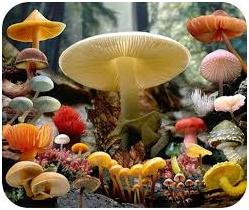
Fungi make an extraordinarily important contribution to managing disease in humans and other animals.Fungi are involved in the industrial processing of more than 10 of the 20 most profitable products used in human medicine. Two anti-cholesterol statins, the antibiotic penicillin and the immunosuppressant cyclosporin A are among the top 10.
The role of fungi was established early in history. Yeasts have been used in the making of bread and alcohol since the beginning of civilisation. In modern times, the discovery of penicillin marked the beginning of a new approach to microbial diseases in human health. More recent approaches include the application of hydrophobins to surfaces leading to biocompatibility of implants, and to emulsion formation improving drug delivery. The established importance of fungi is being expanding way beyond their capacity to transform and protect.
Antibiotics From Fungi
penicillin is obtained from the fungus Penicillium chrysogenum , used to treat an infection caused by a bacterium. Use of penicilin revolutionised the treatment of pathogenic disease. Many formally fatal diseases caused by bacteria became treatable, and new forms of medical intervention were possible.
Modifications to manufacturing conditions have resulted in the development of oral forms. However, antibiotic resistance among bacteria is becoming an extremely important aspect determining the long-term use of all antibiotics.
Cephalosporins also contain the beta lactam ring. The original fungus found to produce the compounds was a Cephalosporium, hence the name. As with penicillin, the cephalosporin antibiotics have a number of disadvantages. Industrial modification of the active ingredients has reduced these problems.
Griseofulvin source was Penicillium griseofulvin. Griseofulvin is fungistatic, rather than fungicidal. It is used for the treatment of dermatophytes, as it accumulates in the hair and skin following topical application.
More recently, several new groups have been developed. Strobilurins target the ubihydroquinone oxidation centre, and in mammals, the compound from fungi is immediately excreted. Basidiomycetes, especially from tropical regions, produce an enormous diversity of these compounds.
Immune Suppressants
Cyclosporin A is a primary metabolite of several fungi, including Trichoderma polysporum and Cylindrocarpon lucidum. Cyclosporin A has proven to be a powerful immunosuppressant in mammals, being widely used during and after bone marrow and organ transplants in humans. Cyclosporin A is a cyclic peptide consisting of 11 mainly hydrophobic amino acids. Its inhibition of lymphocytes was first discovered during the 1970s. Subsequently, the mode of action was elucidated.
Calcineurin is also highly conserved amongst phylogenetically diverse organisms. In fungi such as the human pathogen Cryptococcus neoformans, calcineurin is necessary for recovery from cell cycle arrest, growth in hypertonic solutions and regulation of the calcium pump. Thus the interaction of the Cyclosporin A/cyclophilin complex with calcineurin in Cryptococcus will result in death of the pathogen. However, in humans, cyclosporin also suppresses the immune system. The side effect is an unacceptable risk, and Cyclosporin A is not used as a fungicide in humans at present.
Gliotoxins also have immunological and antibiotic activity. Produced by many fungi including Aspergillus fumigatus, gliotoxins belong to a class of compounds called epipolythiodioxopiperazines. The antibiotic activity is widely recognised and considered uninteresting. However, its effect on the immune system, especially macrophages, is being re-examined.
A wide range of other compounds with antibiotic activity are also known. They have been rejected for use in medicine because of unwanted side effects, or instability of the active compound.
Ergot Alkaloids
Claviceps purpurea is the causal agent of St Anthonies fire, a scourge of the middle ages when ergots contaminated flour.The ergots contain many alkaloids. Their effects are quite variable. They act on the sympathetic nervous system resulting in the inhibition of noradrenaline and sclerotin, causing dilation of blood vessels. They also act directly on the smooth muscles of the uterus causing contractions, thus their early use to induce abortion. Their strongest effect is intoxication, caused by lysergic acid amides, one of which is the recreational (and illegal) drug, LSD.
Statins
Aspergillus terreus, a soil-borne fungus, produces a secondary metabolite called lovastatin and Phoma sp produces squalestatin. Statins have been used to reduce or remove low density lipoproteins from blood vessels in humans.







